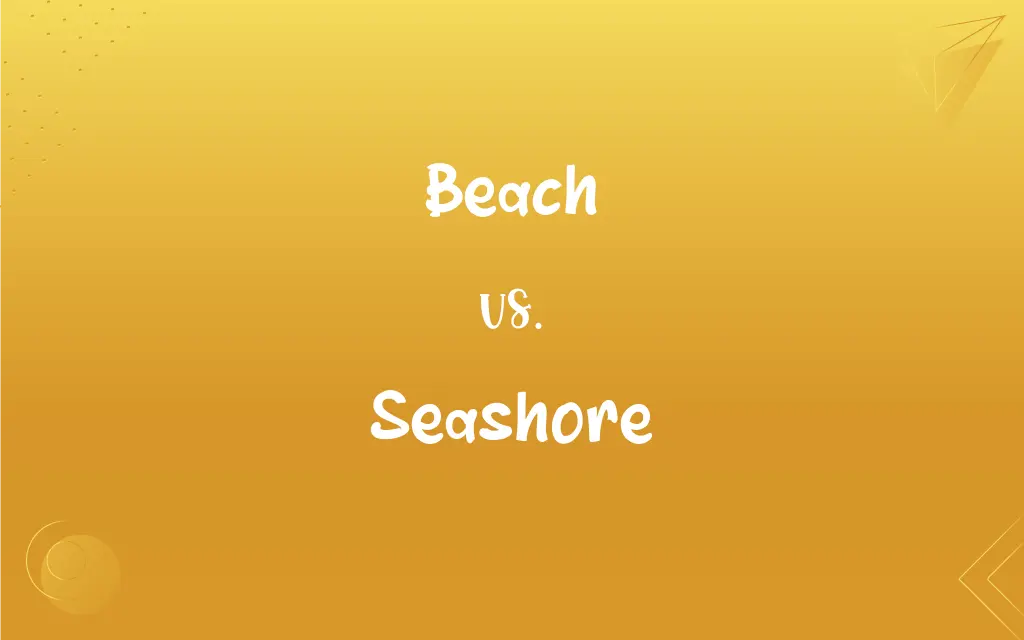Beach vs. Seashore: What's the Difference?
Edited by Harlon Moss || By Janet White || Published on December 12, 2023
A beach is a sandy, pebbly, or rocky shore of a body of water, while the seashore encompasses the broader area where the land meets the sea, including beaches and cliffs.

Key Differences
A beach specifically refers to the sandy, pebbly, or rocky shoreline along a body of water, typically an ocean or sea, known for its recreational uses like sunbathing and swimming. The seashore, however, extends beyond just the sandy stretch to include the entire area where the land meets the sea, encompassing beaches, rocks, cliffs, and coastal ecosystems.
Beaches are characterized by their loose surface materials such as sand, gravel, or pebbles, shaped by the action of waves and tides. The seashore includes these beach areas but also covers geological features like cliffs and dunes, and can encompass habitats such as tidal pools and mangroves.
The term 'beach' often brings to mind leisure activities like beach volleyball, sunbathing, and coastal walks, focusing on the accessible and open areas along the water's edge. The seashore, in contrast, might include areas less accessible for recreational activities, such as rocky headlands or protected natural reserves.
A beach is a dynamic environment where sediment is constantly being deposited and eroded by natural forces, often changing with seasons and storms. The seashore represents a broader ecological zone where various land and marine ecosystems interact, influenced by both terrestrial and marine processes.
A beach is a specific type of shoreline, often used for recreational purposes, while the seashore encompasses the wider interface between land and sea, including the beach as well as other coastal features and ecosystems.
ADVERTISEMENT
Comparison Chart
Definition
Sandy, pebbly, or rocky shoreline of a body of water
Area where land meets the sea, including beaches and cliffs
Composition
Primarily composed of loose materials like sand, gravel, pebbles
Includes a variety of landscapes: beaches, rocks, cliffs, dunes
Recreational Use
Known for activities like sunbathing, swimming, and walking
Encompasses recreational beaches and less accessible areas
Geological Features
Characterized by dynamic sediment deposition and erosion
Includes diverse geological and ecological features
Ecological Zone
Part of the coastal environment, affected by tides and waves
A broader zone where various terrestrial and marine ecosystems interact
ADVERTISEMENT
Beach and Seashore Definitions
Beach
A beach is often a popular recreational area for swimming, sunbathing, and beach sports.
Every summer, tourists flock to the beach for volleyball tournaments.
Seashore
The seashore is the area where land meets the sea, encompassing beaches and other coastal features.
The seashore along this coast is known for its dramatic cliffs.
Beach
Beaches are natural areas formed by the accumulation of sediment along shorelines.
The beach near our house has the softest sand.
Seashore
The seashore is a zone affected by both marine and terrestrial influences.
Erosion and sea level rise significantly impact the seashore.
Beach
Beaches serve as dynamic environments, changing shape with tides and weather.
The beach looks different every year due to coastal erosion.
Seashore
Seashores include a diverse range of habitats, from sandy beaches to rocky cliffs.
The seashore's tidal pools are teeming with marine life.
Beach
A beach is a narrow strip of land along the edge of a sea, lake, or river, covered with sand, gravel, or pebbles.
We spent the day relaxing on the sunny beach.
Seashore
Seashores often feature ecological and geological diversity, including dunes, headlands, and estuaries.
The seashore here is protected as a natural reserve.
Beach
A beach can be a habitat for various forms of marine life and birds.
The beach is home to a variety of shorebirds and sea creatures.
Seashore
Seashores can be areas of significant environmental and scientific interest.
Biologists conduct research on the diverse ecosystems along the seashore.
Beach
The shore of a body of water, especially when sandy or pebbly.
Seashore
Land by the sea.
Beach
The sand or pebbles on a shore.
Seashore
The coastal land bordering a sea or an ocean.
Seashore
The foreshore, the strip of land between low water and high water.
Seashore
The coast of the sea; the land that lies adjacent to the sea or ocean.
Seashore
All the ground between the ordinary high-water and low-water marks.
Seashore
The shore of a sea or ocean
FAQs
What is a seashore?
A seashore is the area where the land meets the sea, including the beach and surrounding coastal environment.
Are all beaches sandy?
Not all beaches are sandy; some have pebbles, rocks, shingle, or other sediments.
What activities are common on beaches?
Common activities on beaches include swimming, sunbathing, surfing, and beachcombing.
What is the main feature of a beach?
The main feature of a beach is its stretch of sand, pebbles, or other sediment along the water's edge.
What does the seashore include?
The seashore includes the beach, cliffs, dunes, and the adjacent marine ecosystem.
What activities occur at the seashore?
Activities at the seashore include beach activities, as well as hiking, bird watching, and exploring marine life.
What ecosystems are characteristic of seashores?
Seashore ecosystems can be more diverse, including tide pools, coastal dunes, and nearby marine and terrestrial habitats.
What ecosystems are found on beaches?
Beach ecosystems typically include various birds, marine animals, and plant life adapted to sandy environments.
How are beaches formed?
Beaches are formed by the deposition of sediments carried by waves, tides, and currents.
What is a beach?
A beach is a landform alongside a body of water, typically consisting of loose particles like sand, gravel, or pebbles.
Do beaches vary in color?
Yes, beaches can vary in color, from white to black, depending on the mineral composition and organic matter.
Can a seashore exist without a beach?
Yes, a seashore can exist without a traditional sandy beach, as it may have rocky shores or cliffs.
How does erosion affect beaches?
Erosion can significantly alter beaches, leading to the loss of beach area and changes in shape.
How is the seashore environment shaped?
The seashore environment is shaped by a combination of marine and terrestrial factors, like waves, tides, and coastal landforms.
Does the seashore have different types of terrain?
Yes, the seashore can have varied terrains, including rocky cliffs, sandy beaches, and mudflats.
Are beaches important for tourism?
Beaches are major attractions for tourism, offering recreational and scenic value.
Why is the seashore important ecologically?
The seashore is important ecologically as it supports diverse habitats and acts as a buffer zone protecting inland areas.
How does erosion impact the seashore?
Erosion can impact the seashore by altering coastal landscapes and affecting both marine and terrestrial ecosystems.
Can human activity harm beaches?
Yes, human activities like pollution, construction, and overuse can harm beaches.
What human impacts affect the seashore?
Human impacts on the seashore include pollution, coastal development, and altering natural coastal processes.
About Author
Written by
Janet WhiteJanet White has been an esteemed writer and blogger for Difference Wiki. Holding a Master's degree in Science and Medical Journalism from the prestigious Boston University, she has consistently demonstrated her expertise and passion for her field. When she's not immersed in her work, Janet relishes her time exercising, delving into a good book, and cherishing moments with friends and family.
Edited by
Harlon MossHarlon is a seasoned quality moderator and accomplished content writer for Difference Wiki. An alumnus of the prestigious University of California, he earned his degree in Computer Science. Leveraging his academic background, Harlon brings a meticulous and informed perspective to his work, ensuring content accuracy and excellence.








































































